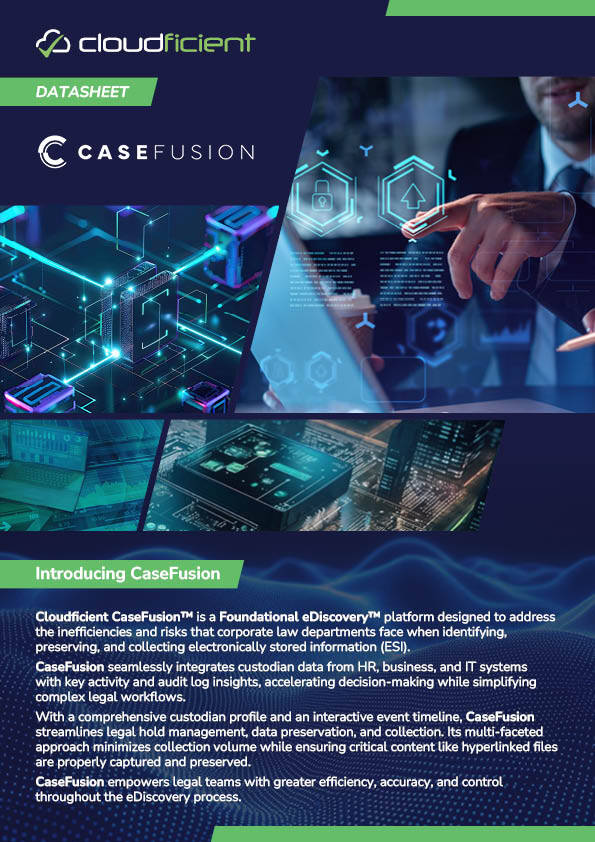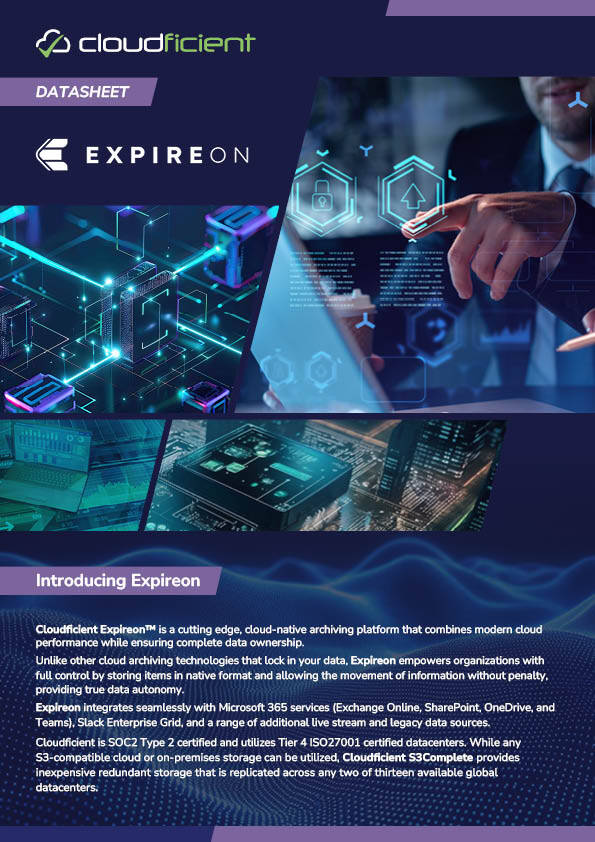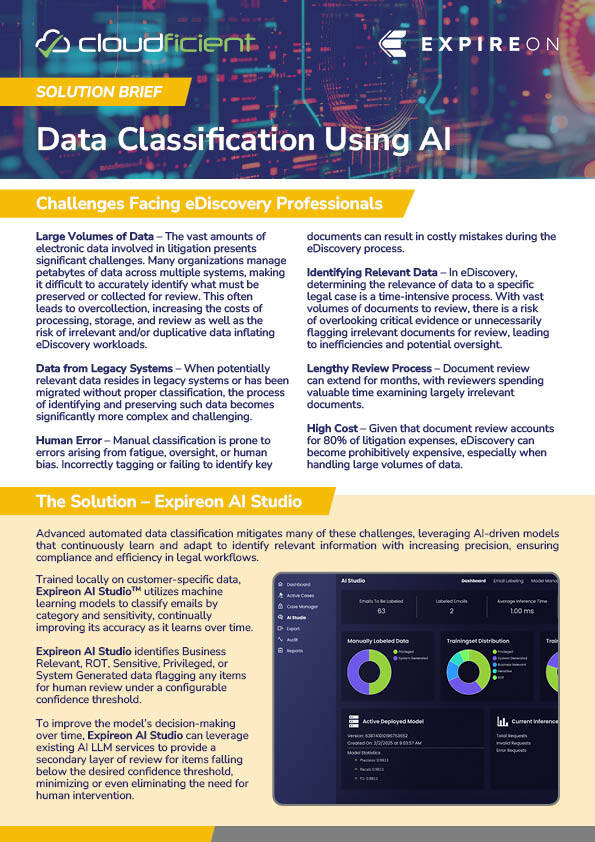- Solutions
- Foundational eDiscovery
- Export & Review
Data Export for Legal Document Review
Managing data export operations across fragmented technology environments while preparing massive datasets for efficient document review is a challenge for modern enterprises. Traditional data export methods often break down when faced with multi-platform integration, preserving hyperlinked content, and intelligent classification to reduce review costs. Organizations require comprehensive solutions that streamline data export, optimize review workflows, dramatically reduce costs through intelligent classification, and ensure the defensible handling of evidence throughout the eDiscovery lifecycle.
Challenges of Preparing Review-Ready Data Export
Modern enterprises face increasing complexity in managing data exports for document review. Organizations struggle with fragmented ecosystems where critical information must be extracted from multiple platforms while maintaining integrity, completeness, and defensibility throughout legal discovery.
Data Export Complexity Across Multi-Platform Environments
Traditional data export methods fail when confronted with interconnected modern enterprise systems. Organizations typically manage data across Microsoft 365, Slack, legacy archives, acquired company systems, and cloud platforms, none of which offer unified export workflows. This creates significant challenges:
-
-
Platform-specific export limitations: Each system requires different export procedures, leading to inconsistent data formats and metadata preservation during review preparation.
-
Integration blind spots: Relationships between systems are often invisible during data exports, resulting in incomplete datasets that threaten legal defensibility.
-
Legacy system complexity: Outdated databases and file servers contain crucial historical information but lack modern export data capabilities that support efficient document review workflows.
-
Cloud sprawl: SaaS applications often sit outside IT oversight, leaving gaps in exported data that surface at the worst possible moment, during litigation.
-
These challenges force legal teams to work with incomplete datasets, increasing the risk of missing key evidence and compromising case outcomes.


Hyperlinked Content Gaps During Export Data Operations
Modern collaboration platforms create complex webs of hyperlinks and embedded references that most export tools can’t preserve. SharePoint, Teams, and email systems generate dynamic content relationships that often hold critical evidence. Key issues include:
-
Reference preservation failures: Standard exports fail to capture hyperlinked documents contemporaneously - missing the version that existed when a message was sent.
-
Dynamic content challenges: Live documents that update in real-time complicate efforts to export a legally defensible snapshot.
-
Cross-platform dependencies: Hyperlinked content often spans multiple systems, creating critical evidence gaps.
-
Embedded media complexity: Multimedia elements and external links are often overlooked during exports.
Organizations that overlook these challenges risk incomplete evidence and costly disputes during discovery.
Bates Numbering and Production Validation Pitfalls
Received productions often contain flaws that go undetected until expensive document review phases are already underway. Law firms and legal service providers lack automated tools to validate export data integrity, leading to significant risks:
-
Bates gaps detection: Missing sequential numbers signal incomplete productions that require urgent fixes before review deadlines.
-
Metadata inconsistencies: Corrupt or incomplete metadata undermines document authenticity.
-
Missing custodian information: Productions often lack proper attribution, making it hard to verify sources.
-
File reference gaps: Hyperlinked documents in emails or chats may be absent, leaving holes only discovered during a detailed review.
These failures expose organizations to discovery disputes and can derail case strategies when evidence gaps surface too late.


Manual Review Preparation Bottlenecks
Without intelligent export classification, legal teams must sift through vast volumes of irrelevant content. Traditional approaches fail to distinguish between business-relevant materials and ROT data, creating:
-
Unfiltered data export: Standard export data operations capture all content regardless of relevance, inflating document review costs through unnecessary processing of system-generated and duplicate files.
-
Classification delays: Manual sorting of data creates bottlenecks that delay document review timelines and increase legal risk during time-sensitive litigation.
-
Failure to flag privileged material early: Potentially privileged communications need automated screening, or they risk flowing into document review workflows, creating security and efficiency risks.
-
Content categorization gaps: Without AI-powered classification during data export, legal teams cannot prioritize high-value content for expedited document review.
These manual processes place unnecessary burdens on legal teams and inflate document review costs by over 60% through inefficient content processing.
Legacy Systems and Departing Employee Data
Enterprise organizations struggle to efficiently export data from disparate legacy systems, acquired company infrastructure, and departing employee accounts. These challenges create fragmented datasets that compromise document review effectiveness:
-
Legacy archive access: Outdated email archives and file systems often lack modern export data capabilities, requiring specialized tools and extended timelines for document review preparation.
-
Acquired company integration: Merger and acquisition activities create isolated data repositories that resist standard export processes.
-
Employee departure challenges: Data from departing employees must be exported quickly to preserve critical evidence, but manual processes often lead to gaps, loss, or incomplete preservation.
-
System decommissioning risks: Retiring legacy systems often hold valuable historical data that can be lost without proactive export efforts to support future document review needs.
Organizations that fail to address legacy integration challenges face increased litigation risk through incomplete data preservation and elevated document review costs.


Custodian Mapping Blind Spots
Organizations often lack visibility into custodian relationships and data dependencies, leading to over-collection or under-collection. This creates significant risks:
-
Custodian identification delays: Without automated custodian mapping, manual processes often overlook key individuals and their data sources, slowing export planning and increasing the risk of missed evidence.
-
Hidden data relationships: Complex organizational structures can obscure which custodians have access to critical repositories, leading to incomplete exports and defensibility gaps.
-
Role transition challenges: Job changes and departmental moves create mapping blind spots that often surface only during high-pressure litigation exports.
-
Cross-department dependencies: Data relationships spanning multiple business units demand advanced mapping to ensure complete and defensible collections.
These custodian mapping blind spots result in either excessive export data volumes that inflate document review costs or insufficient data collection that exposes organizations to discovery sanctions.
Maintaining Data Integrity During Exports
Legal teams often struggle to preserve data integrity throughout export operations, putting the authenticity and admissibility of documents at risk. These challenges become even more critical if upstream preservation and collection processes aren’t managed carefully. When quality control breaks down, organizations face significant legal exposure:
-
Metadata corruption: Failure to preserve original metadata can compromise document authenticity and render evidence inadmissible in court.
-
Format inconsistencies: Exporting across multiple platforms often leads to formatting issues that disrupt review workflows and production consistency.
-
Chain of custody gaps: Poorly documented export procedures undermine defensibility and leave organizations vulnerable to discovery challenges.
-
Version control failures: Missing or incorrect document versions can create confusion during review and lead to the production of outdated or inaccurate materials.
Without robust export quality controls, organizations risk compromised evidence, discovery disputes, and even sanctions during litigation.

Implement Standardized Data Export Protocols
Establish consistent data export protocols across all eDiscovery matters to ensure reliability and defensibility while reducing operational complexity. Create comprehensive procedures that define export formats, metadata preservation requirements, and validation steps for each stage of the process. Standardized protocols prevent costly errors and ensure consistency regardless of case complexity or timeline pressures.
Optimize Export Data Validation Processes
Implement comprehensive data validation to prevent costly production errors and ensure complete, defensible exports that meet court requirements. Deploy multi-stage validation processes that verify file integrity, metadata completeness, and formatting consistency before final production. Advanced validation tools identify missing hyperlinked documents, detect Bates gaps, and verify custodian information completeness during early case assessment.
Streamline Document Review Data Preparation
Implement efficient data preparation workflows that eliminate irrelevant content while ensuring complete preservation of potentially responsive materials. Deploy AI-powered classification systems that analyze content context and automatically categorize documents by relevance, privilege, and sensitivity levels. Solutions need to provide advanced classification capabilities that can reduce review volumes while maintaining comprehensive coverage of relevant materials.
Establish Data Review Chain of Custody Documentation
Maintain a comprehensive chain of custody documentation to ensure defensible evidence handling and provide detailed audit trails necessary for courtroom presentation. Implement automated logging systems that capture all user actions, system modifications, and data transfers without relying on manual entry. Look for a SOC2 Type 2 certified solution that maintains detailed activity logs while ensuring data integrity throughout the review process.
Deploy AI-Enhanced Export Data Classification
Implement machine learning solutions that analyze content context, communication patterns, and business relationships to identify potentially relevant information early in the EDRM process. Advanced AI classification systems utilize customer-specific learning models to identify business relevant, ROT, sensitive, privileged, and system generated data while reducing review volumes by up to 40%.
Our Solutions
Our integrated platform eliminates the complexities of data export and document review preparation to reduce the traditional risks inherent to modern eDiscovery workflows. We deliver automated, defensible solutions for export data operations and intelligent document review optimization across entire enterprise environments.
Expireon - Cloud-native data export platform that reduces downstream review costs by about 40% and delivers seamless extraction and legal review preparation through unified custodian data mapping, automated export workflows, and hyperlinked content preservation capabilities that ensure complete evidence collection across multi-platform enterprise environments.
Expireon AI Studio - Accelerates document review workflows by using AI-powered classification that automatically identifies legally relevant content, filters ROT data during extraction, and reduces manual review preparation time by up to 40%.
Hyperlize - Production validation platform that analyzes exported data and load files to identify missing hyperlinked documents, detect Bates numbering gaps, and validate export data completeness before document review begins, preventing costly supplemental requests and litigation liabilities.
CaseFusion - Foundational eDiscovery platform that reduces downstream review costs by about transforms data export for legal review by unifying enterprise systems to enable comprehensive custodian identification, automated legal hold workflows, and complete hyperlinked file collection that captures the correct document version needed for defensible document review preparation, and reduces review data volumes by up to 80%.
Frequently Asked Questions
What is document review in law?
Document review is the process of examining electronically stored information to determine relevance, privilege status, and importance to legal matters. During this phase, legal teams analyze documents to identify key evidence and determine what should be produced to opposing parties. Efficient document review is essential for controlling legal expenses while ensuring reviewers have complete, properly formatted datasets. Effective early case assessment reduces data volumes to lower costs downstream.
What is data export in legal document review?
Data export is the process of extracting electronic information from various enterprise systems to prepare it for legal document review. This includes pulling data from Microsoft 365, Slack, legacy systems, and cloud platforms while preserving metadata, hyperlinks, and data integrity. Effective export ensures that all potentially relevant information is captured defensibly and formatted appropriately for review workflows.
What is Bates Numbering and why is it important?
Bates numbering is a sequential numbering system that is applied to documents during legal discovery. It creates unique identifiers for each page or document. This system ensures that documents can be referenced consistently throughout litigation and helps maintain organization during document review.
What does redacted mean?
Redacted means that sensitive, privileged, or confidential information has been removed or obscured from a document before it is produced for legal proceedings. Redaction typically involves blacking out or covering specific text, names, or sections to protect sensitive information. Proper redaction ensures that sensitive information is protected while maintaining a document’s overall context and admissibility.
How do hyperlinks complicate eDiscovery?
Traditional eDiscovery workflows were built to handle static attachments, not dynamic files. Content that can change over time needs to be captured contemporaneously so that the version “as sent” is preserved. Missing hyperlinked content creates evidence gaps that can be discovered during review, leading to costly supplemental productions and potential discovery disputes
.png?width=620&height=82&name=Untitled%20design%20(18).png)
.png?width=600&height=79&name=Untitled%20design%20(18).png)
-3.png?width=250&height=33&name=Untitled%20design%20(18)-3.png)






